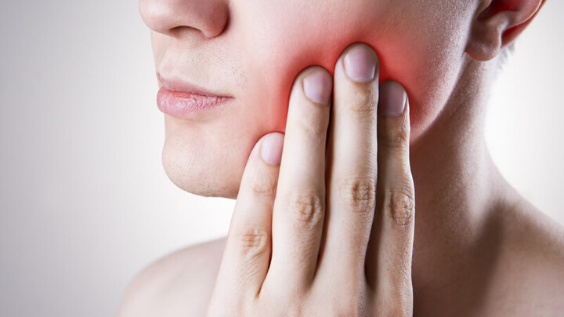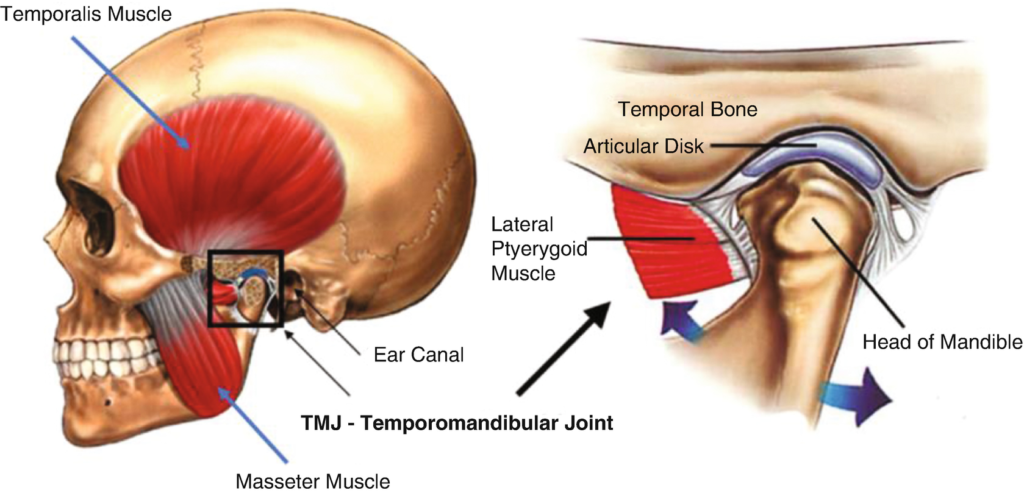
Have you ever awakened in the morning with a sore jaw, or found that it is painful to open your mouth? Perhaps your jaw clicks on one side or even both. Do your ears feel clogged even though you don’t have an infection? Maybe you have dizzy spells, ringing in the ears or unexplained headaches. If you experience any of these, you may be suffering from TMJ disorder. TMJ, or temporomandibular joint, refers to the complex joint where the lower jaw hinges with the upper jaw. When it is working properly, you can open your mouth wide and slide your lower jaw from side to side as well as a little forward and back! You can’t do that with your knee or hip—so think of how many muscles must be involved!
Stress and anxiety cause many people to clench their jaw and grind their teeth at night. This continual flexing of the jaw muscles leads to chronic tension and even little knots in the muscles. Think how much your hand would hurt if you clenched your fist as hard as you could most of the day and night! TMJ pain is usually felt at the joints, just in front of the ears, but can also be felt in the muscles that operate the jaw causing headaches, neck pain, and even ear conditions like a “clogged” feeling or tinnitus. Muscle tension in the neck and shoulder can pull your jaw out of alignment, which can lead to TMJ, as can trauma to the head or jaw or habits like gum chewing, only chewing food on one side of the mouth and even fingernail biting.
Traditional Chinese Medicine (TCM) is one of the best ways to treat TMJ disorder. Acupuncture can relax the local muscles and decrease the symptoms of pain and ear discomfort. In addition to acupuncture, herbs, tuina, nutrition and meditation can be used to ease anxious tension, which allows the jaw to return to a proper alignment and produces more restful sleep.
For structural damage caused by trauma, or where uneven use has lead to teeth problems, a dental specialist must also contribute to the healing process. Even in these cases, TCM works as a great addition to help ease pain both before and after the procedures.

What is a Temporomandibular Joint Disease?
TMJ or temporomandibular joint disease is a common problem with a complex treatment. The usual symptoms are: numbness of the jaw and temporal area, and dull and/or sharp pain of previously mentioned areas (temporal headache).
Some of the causes of TMJ include stress (grinding the teeth), direct trauma, or bad diet habits. The majority of these patients use dental appliances or pain medication with no avail.
Treatment:
Unfortunately, pharmaceutical treatments only provide symptomatic relief of TMJ. However, acupuncture can target the root cause of the condition by balancing the mind and body through a network of energy channels called meridians, helping to reset the neuromuscular tension in the jaw. Often TMJ is due to underlying stress held in the jaw or contracted muscles in the jaw and face. Acupuncture can help to both relax these targeted muscles and decrease the overall stress level in the body to relieve TMJ discomfort.
Acupuncture is frequently used to treat TMJ with positive results. As a long-standing treatment approach, research has determined the recommended acupuncture points, frequency, and duration of acupuncture treatment for TMJ-related problems. In treating TMJ, acupuncturists often find a deficiency in Qi in the liver (LV) meridian and an excess of Qi in the gallbladder (GB) meridian.
The treatment frequency is once a week for 4-6 weeks. Within 6-8 treatments, the patient should be able to feel some improvement. Pain and/or burning is reduced, the range of motion of the jaw is increased, and pain medication is reduced or discontinued.
Although millions of people use acupuncture each year, often for chronic pain, there has been considerable controversy surrounding its value as a therapy and whether it is anything more than placebo. However, research of traditional Chinese medicine revealed that acupuncture is effective in the treatment for temporomandibular disorders and myofascial pain
As with almost all muscles disorders, the recommendation of the appropriate massage and stretching exercises for the muscles involved will assist in a speedy recovery. A course of daily massage and stretching is recommended as part of the protocol to reduce stress of the temporomandibular joint. It is convenient to apply heat for 15 to 20 minutes before the stretching exercises are done to increase the elasticity of the muscles.
